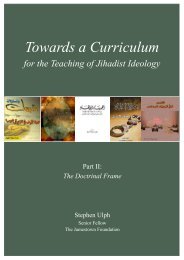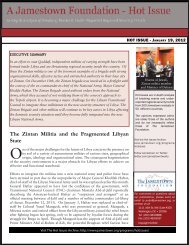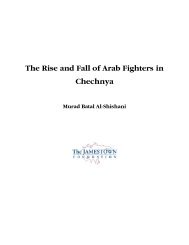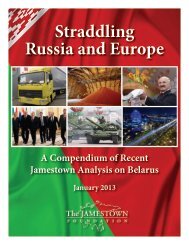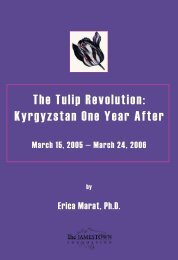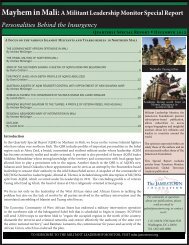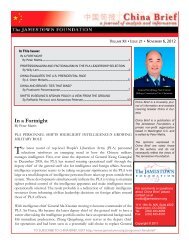By Brian Glyn Williams - The Jamestown Foundation
By Brian Glyn Williams - The Jamestown Foundation
By Brian Glyn Williams - The Jamestown Foundation
You also want an ePaper? Increase the reach of your titles
YUMPU automatically turns print PDFs into web optimized ePapers that Google loves.
communicate and direct the mounted formations. <strong>The</strong> Tatars usually relied on flank attacks and<br />
surprise charges to break up the enemy's positions. When attacked by formed bodies of enemy<br />
cavalry, the Tatars would frequently scatter and fake a retreat, shooting arrows from the saddle, then quickly<br />
re-group and attack the enemy whose formations were often strung out in pursuit. When confronted with<br />
impenetrable enemy formations, the Tatars poured arrow fire into the enemy's ranks, harried their<br />
detachments and cut off stragglers often wearing down the resistance of a stronger enemy.<br />
This was the nature of the Mehemed II's new allies the Crimean Tatars. From 1478, the Ottomans could<br />
usually rely on the assistance of the hardy Tatar horsemen who provided the Sultan with some of the<br />
finest cavalry in the world. <strong>The</strong> Ottoman army, which was made up for the most part of sipahis<br />
(horsemen), used light cavalry far more extensively than their European opponents and there was<br />
always a need for more riders in the Sultan’s ranks. Cavalry units played a far greater role in the Ottoman<br />
armies than historians have given credit and greatly outnumbered the legendary janissarys (slave infantry)<br />
whose role has been exaggerated. A seventeenth century observer wrote that the Ottoman Sultan<br />
"maintaineth an hundred and fifty thousand horsemen, excellent well armed...So great a Cavalry can no<br />
other Prince maintain with the yearly expense of fourteen millions of gold...Herein consisteth the<br />
chieftest Preservation of the Ottoman Empire." 27<br />
<strong>The</strong> Crimean Tatars could usually be relied upon to send at least 20,000 riders to enlarge the already fearsome<br />
Ottoman army. <strong>The</strong>ir forces were easily maintained on campaigns and, unlike the Ottoman sipahis, they<br />
did not require land grants from the Ottoman government in return for their services. Mehemed II<br />
must have, however, had his doubts about employing the Tatars. It was well-known that a Tatar<br />
defection during the battle of Ankara in 1402 had resulted in the death of his grandfather, Sultan Bayezid<br />
I, and almost caused the destruction of the Ottoman Empire. 28 Mehemed II must have wondered if the<br />
Crimean Tatars would be any more reliable or effective than their ancestors.<br />
That the Crimean Tatars could fight effectively in steppe conditions was beyond doubt, the question to be<br />
answered is how effective was their assistance on the various Ottoman fronts from the Caspian to Vienna?<br />
It is to the answering of this question that this paper will now be devoted.<br />
8




